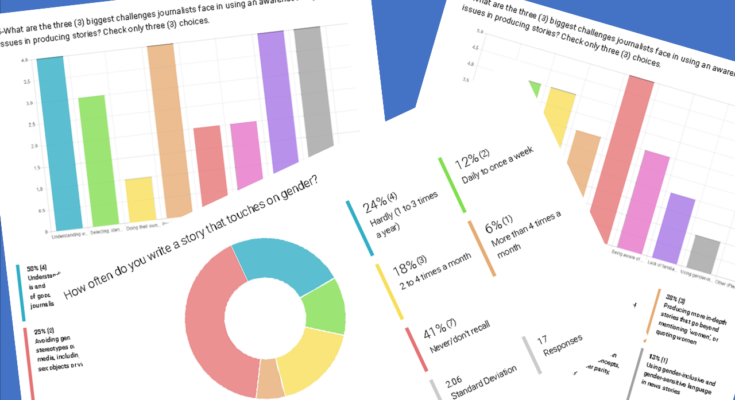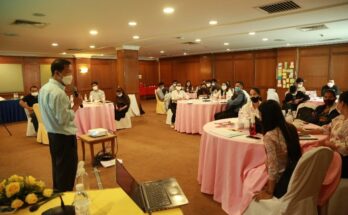The use of gender as an indicator of a good news story was rated as important by more than 95% of respondents in a survey carried out by the Cambodian Center for Independent Media (CCIM) among journalists, editors and media trainers in the country. But they also said that the biggest challenges in producing gender-aware stories lie in avoiding bias and stereotypes of women and in identifying strong story ideas and angles.
These insights are among the perspectives drawn from the online survey, through which CCIM wanted to find out media professionals’ understanding around the use of gender as a tool in news work.
Conducting this survey is part of CCIM’s contribution to the production of a gender learning kit for Cambodian media. The survey highlights provide local context into this kit, which is to be produced under the South East Asia Media Training Network (SEAMTN) project of Sweden’s Fojo Media Institute.
“Based on the result of this survey, many journalists did not understand deeply about the gender in journalism’s work yet,” said Chanden Mak, CCIM training coordinator. “This training kit is very important for conducting training among those journalists and young new journalists, to make sure that they can cover gender issues with professional journalism in the future.”
There were 45 respondents to the survey, whose 10-point questionnaire was circulated from December 2020 and February 2021.
The questionnaire was sent out in English and Khmer to three types of respondents: journalists from different media houses and reporters who were reporter trainees of CCIM’s Newsroom Cambodia (25 respondents or 56% of the total), editors (11 or 24%) and trainers/teachers (nine or 20%).
Seventy-six percent of the total respondents were male, and 24% female. They were a mix of professionals from 19 local and international media institutions, across print, radio, TV and online media in Phnom Penh.
Majority, or 64% of the respondents, have been in journalism from six to 15 years. Among editors and trainers, 80% of respondents have attended events or training programmes at CCIM before, while 20% replied in the negative.
Respondents were asked to rate the importance of gender “as an indicator of how good a story is” in their work, whether as journalist/trainee, editor or trainer, by selecting one among a range of five options, with 1 meaning ‘not important’ and 5 indicating it was ‘extremely important’.
An average of 95% of all respondents chose varying degrees of importance for gender, choosing one among the responses 3 meaning ‘important’, 4 or ‘very important’ and 5 for ‘extremely important’.
Broken down by type of respondent, all of the nine trainers said gender was important. Ninety-six percent of reporters/CCIM trainees said the same, and so did 90% of editors.
Among the trainers, 55% said gender was ‘very important’. The biggest proportion among editors, or 36%, also chose this reply. But among the journalists, it was the ‘extremely important’ option that got the highest percentage of replies at 48%. None of the respondents said gender was ‘not important’ in judging editorial quality.
Very few – just 2 or 5% among journalists and editors selected option 2 or ‘slightly important’. No trainer ticked this option.
The questionnaire explored respondents’ views about a mix of issues, such as how they understood gender, what challenges they see in using gender in news reporting, and their experiences writing, editing or training around it.
Asked to select two among five options that best reflect the meaning of the word ‘gender’, the two most often-selected replies were: ‘equality between men and women’, which was ticked by 53% of respondents, and ‘how the gender of individuals and communities and their location in society shape their lives, human rights and development’, which 47% of respondents selected.
The three other options given were: ‘more women as presidents and prime ministers’, ‘feminism’ and ‘avoiding the identification of sources in news stories as men, women or other genders’.
HOW DIFFICULT?
The respondents were asked to rate the degree of difficulty for journalists ‘to understand gender and use this in news reporting’, by selecting from options ranging from 1 for ‘not difficult’ to 5, meaning ‘extremely difficult’. Sixty-four percent of them said they found gender to be either ‘difficult’, ‘very difficult’ and ‘extremely difficult’ (options 3 to 5).
An analysis of the results for each respondent group shows that the journalists/reporters and editors, whose work involves production of stories, tended to give higher degrees of difficulty to using gender in their work, when compared to the trainers.
Among reporters, a total of 40% said they found gender ‘difficult’ to understand and use in news reporting. Among editors, 55% said it was ‘difficult’.
One among the editor-respondents and one in the reporters’ group said that gender is ‘not difficult’, while two reporters said it is ‘extremely difficult’ for journalists to understand gender and use this in news reporting.
Among the nine trainer-respondents, 33% selected ‘slightly difficult’, another 33% chose ‘difficult’, 11% went for ‘very difficult’ and 22% (2 trainers), ‘extremely difficult’).
What, exactly, are these difficulties? The respondents were asked to choose three among eight options that they consider the journalists’ biggest challenges in using gender in news stories.
The three types of difficulties that most often selected by the respondents (23 respondents or 35%) were ‘avoiding gender bias and stereotypes of women in media, including mostly as sex objects or victims’, ‘selecting, identifying concrete, strong story ideas and angles that involve gender’ (selected by 35%), and ‘understanding what gender is and why it is an indicator of good, professional journalism’ (31%).
At the same time, the top choices show some differences per respondent group – among editors, reporters/trainees and trainers. The top three replies among the editors was ‘avoiding gender bias and stereotypes of women’ (21%), ‘selecting story ideas and angles’ (18%) and ‘doing their own, independent analyses of stories that are shaped by gender and the power relations in them’ (13%).
Among reporters/trainers, 17% chose ‘avoiding gender bias and stereotypes of women’ and ‘selecting story ideas and angles’ as well, followed by 16% choosing ‘understanding what gender is’.
Interestingly, the trainers’ views were different from the reporters and editors, offering potential assessment of what issues to focus on in future training on gender in news. Among them, 19% chose the difficulty in ‘using gender-inclusive and gender-sensitive language in news stories’, 15% selected ‘lack of familiarity with gender-related concepts such as gender parity, patriarchy’, and another 17% chose ‘selecting story ideas and angles’.
To find out about their experience in writing, editing or training on gender issues, the respondents were asked “How often do you write or edit the story that touch or relevant to gender?”
An average of 45% of all respondents say they have produced and/or assigned or edited a story that discusses gender. Thirty percent said they have ‘never produced and/or edited’ such a story, 25% of respondents are uncertain about this.
A look at the responses from trainees/journalists and editors shows that 39% of them said they write or a story related to gender 1 to 3 times a year, 21% write or edit 2 to 3 times a month, 6% do this daily to once a week, 6% more than 4 times a month. A total of 28% replied ‘never/don’t recall’.
Among women trainees/journalists and editors, the figures are slightly different. Thirty-six percent said they produced gender-related stories 1 to 3 times a year, 9% said 2 to 4 times a month, 9% more than 4 times a month, and 45% selected ‘never/don’t recall’).
For CCIM’s Chanden Mak, this set of replies was not exactly surprising. CCIM’s experience has shown, he says, that most journalists often write very few articles related to gender even after finishing training programmes. Many trainees, being freelance journalists, focus on reporting on issues such as environment, human rights, politics and freedom of expression.
HOW ABOUT SKILLS?
Asked to rate their own skills in using gender in news work from a range of options, 22 of the total 25 reporter respondents (88%) said they had some skills in varying degrees and chose replies from 2 or ‘slightly skilled’, 3 meaning ‘skilled’), or 4 meaning ‘very skilled’. The 88% figure reflects the self-rating of 16 reporters who said they were ‘skilled’ (64%), three (13%) who said they were ‘very skilled’ and another three who chose ‘slightly skilled’.
Only one of the reporter-respondents said he/she was ‘not skilled or confident at all’. (Two reporters did not answer this question.)
Editors and trainers were asked to reply to an adjusted version of this question, where they rated the skill of the journalists/trainees they work with. They were asked to use the same range of options, from 1 meaning ‘not skilled at all’ to 5 for ‘extremely skilled’.
All but one (19 respondents, or 95%) of the 20 editors and trainers grouped together for this question, said their reporters and trainees had some skills, in varying degrees. They selected ratings from 2 for ‘slightly skilled’, 3 for ‘skilled’ and 4 for ‘very skilled’.
The 95% rating came from 15 editors and trainers, or 79%, said their reporters and trainees were ‘skilled’, three (16%) who said they were ‘very skilled’ and one (5%)who said they were ‘slightly skilled’). (One of the editors did not respond to this question. )
Asked if they themselves have had training on ‘improving the gender in stories, either as a topic of a story, a tool to develop better stories, or attend training of trainers on gender’, less than half or 45% of the journalists and media trainers answered in the affirmative and 55%, in the negative.
The editors were not asked the same question as above, but were requested to reply to this query: ‘Have you ever given suggestions, feedback to your reporter or staffer in relation to a story you edited or assigned?’ Eight editors or 89% among the editors’ group said they have given suggestions or feedback to their reporters. Only 1 editor has never given such feedback.
For their part, the trainers were asked if they had ever ‘provided training on gender or been a trainer or resource person on the topic as part of a wider event or course’. A total of 44% (4 trainers) of the nine trainers said yes, another 44% said no and 12% (1) was uncertain.
Do the respondents’ media organisations have a style manual that covers gender? Sixty-three percent of respondents said that their organisations have their own style manual, while the rest said ‘no’. Moreover, 69% of the respondents who said yes to the first question said that their style guides include language that journalists are advised to use in stories.
Finally, the questionnaire sought the respondents’ views about the length of a course on gender in reporting, asking them to choose between three days, five days, or one week. Majority – from 62 to 64% – of both reporters and editors preferred a three-day training course, while all trainers favoured this option. Asked if they would send their staff to such a course, all but one of the 11 editor-respondents said they would do so.



